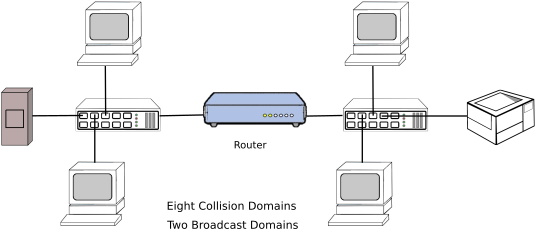A router is a layer device, which means it makes forwarding decisions based on logical network address (for example, IP address) information. Although a router is considered to be a layer 3 device, like a multilayer switch, it has the capability to consider higher-layer parameters, such as quality of service (QoS) settings, in making forwarding decisions.

Figure 9-15 Router Broadcast and Collision Domains
As shown in Figure 9-15, each port on a router is a separate collision domain and a separate broadcast domain. At this point in the discussion, routers are beginning to sound much like multilayer switches. So, why would network designers select a router rather than a multilayer switch in their design?
One reason a router is preferable to a multilayer switch in some cases is that routers are usually more feature rich and support a broader range of interface types. For example, if you need to connect a layer 3 device out to your Internet service provider (ISP) using a serial port, you will be more likely to find a serial port expansion module for your router than for your multilayer switch.
About The Author
Anthony Sequeira, CCIE No. 15626, is a Cisco Certified Systems Instructor (CCSI) and author regarding all levels and tracks of Cisco Certification. Anthony formally began his career in the information technology industry in 1994 with IBM in Tampa, Florida. He quickly formed his own computer consultancy, Computer Solutions, and then discovered his true passion-teaching and writing about Microsoft and Cisco technologies. Anthony joined Mastering Computers in 1996 and lectured to massive audiences around the world about the latest in computer technologies. Mastering Computers became the revolutionary online training company, KnowledgeNet, and Anthony trained there for many years. Anthony is currently pursuing his second CCIE in the area of Security and is a full-time instructor for the next-generation of KnowledgeNet, StormWind.com. Anthony is also a VMware Certified Professional.
CompTIA Network+ N10-008 Cert Guide contains proven study features that allow you to succeed on the exam the first time. Expert instructor Anthony Sequeira shares preparation hints and test-taking tips, helping you identify areas of weakness and improve both your conceptual knowledge and hands-on skills, essential for successful completion of the performance-based testing items on the exam. This complete, CompTIA-approved study package includes the following:
• A test-preparation routine proven to help you pass the exams
• Clearly defined chapter learning objectives covering all N10-008 exam topics
• Chapter-ending review questions and exam preparation exercises, which help you drill on key concepts you must know thoroughly
• The powerful Pearson Test Prep practice test software, complete with hundreds of well-reviewed, exam-realistic questions, customization options, and detailed performance reports
• 40 performance-based exercises to help you prepare for the hands-on exam questions
• A free copy of the CompTIA Network+ N10-008 Simulator Lite software, complete with meaningful lab exercises that enhance your hands-on skills
• More than 60 minutes of video mentoring
• A final preparation chapter that guides you through tools and resources to help you craft your review and test taking strategies
• An Exam Essentials appendix that quickly recaps all major chapter topics for easy reference, both in print and interactive digital format
• A key terms Glossary in both print and on the companion website, which acts as an interactive flash-card application
• Study plan suggestions and templates to help you organize and optimize your study time
• A 10% exam discount voucher (a $33+ value!)
Well regarded for its level of detail, study plans, assessment features, challenging review questions and exercises, video instruction, and hands-on labs, this approved study guide helps you master the concepts and techniques that ensure your exam success.
Master the topics on the CompTIA Network+ N10-008 exam, including:
• Network topologies and media types
• IP addressing
• Network services
• Data center architectures and cloud concepts
• Routing, Ethernet switching, and wireless networking
• Network availability and disaster recovery
• Network security
• Remote access
• Network troubleshooting
Learn more about the CompTIA Network+ N10-008 Cert Guide at amazon.com
More Networking Topologies Articles:
• A Guide to Broadband Internet Connections
• VPN (Virtual Private Network) headend or Concentrator
• Technologies for the Internet of Things (IoT)
• What is an Ethernet Switch?
• Routing Technologies, Bandwidth Management and Traffic Shaping
• Network Storage Server Options
• Cisco Switching Fundamentals
• Understanding Wireless LAN Networking
• Understanding Optical Fiber Types
• Distance Vector vs. Link State vs. Hybrid Routing



